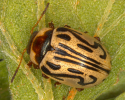Zygogramma bicolorata Pallister |
||
| Order: Coleoptera Family: Chrysomelidae | ||
| Common name / Category: Weed insect of Parthenium hysterophorus | ||
Adults and larvae of Zygogramma bicolorata feed on Parthenium leaves. The eggs are laid singly or in small groups of up to 5, mostly on the undersurface of the leaves and egg period lasts 4-5 days. The early stage larvae feed on the terminal and auxiliary buds and move on to the leaf blades as they grow. The full grown larvae enter the soil and pupate. Larval and pupal periods last 10-15 and 8-10 days, respectively. Each female is capable of laying upto 1,786 eggs (Mean 836.13). |
||
| Production procedure | ||
10 pair of adults (male and female) are placed on bouquets of Parthenium leaves in 14 x 12 cm transparent plastic container. After observance of egg laying such leaves are replaced and fresh bouquets are provided. Such replacement of bouquets in egg laying jars can be repeated for one month. |
||
Small Parthenium plants are removed from soil and transplanted in 45 x 60 x 90 cm cages with zinc sheet trays at bottom. These trays are filled with soil and Parthenium plants are transplanted and watered daily. Once plants start growing, leaves with eggs of Zygogramma bicolorata are placed over them. Around 100-150 eggs can be transferred in one such cage. On hatching larvae feed on leaves and pupate in soil. In such process they consume all plants inside cages. Generally ratio is 10-15 grubs to one plant. This way around 15-20 small plants are provided in each cage. Such cages yield around 100-125 adults. It can also be bred in open field by covering Parthenium plants with walk in field cages and by releasing 1 pair:2 plants. |
||
Such cages can accommodate around 100 plants and yield about 300 adults. |
||
|

